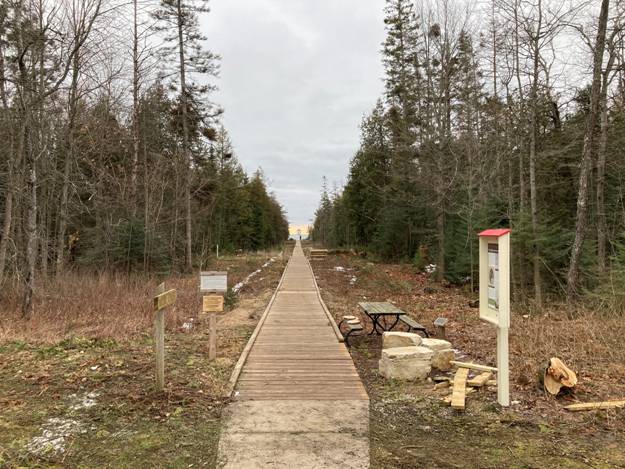Ridges Uses Mandatory Cutting to Boost Research
- Share
- Tweet
- Pin
- Share

A crew’s careful tree-cutting operation near the historic Baileys Harbor Range Lights served two restorative purposes, leaders at The Ridges Sanctuary said.
During a narrow window of cold temperatures and snow cover this winter, workers cut and removed trees and brush without harming the fragile habitat. The work was necessary to widen a tree-free corridor to the 50-foot width required by the 1937 deed when the United States Lighthouse Service transferred the Range Light property to Door County. The U.S. Coast guard mandates the maintenance of the corridor.
“We needed to do it,” Tony Kiszonas, Ridges Director of Research, said of the Upper and Lower Range Lights. “They are active aids to navigation.”
The Ridges staff, including Land Manager Sam Hoffman, will take advantage of the removal of shade-producing trees and brush to collect data on how the plants respond to having more light on habitat including sandy ridges and intermittent wetlands.
The staff did a plant inventory and collected baseline data on how plants thrived or struggled with less sunlight last year. Kiszonas said he has a document with about 150 types of plants, and they will pay particular attention to the response by the sunlight-loving, federally endangered dwarf lake iris.
“Everything we’ve been able to find on dwarf lake iris is that it needs sunlight in order to produce flowers,” Kiszonas said. “There might be a point where too much is not good either.”
In addition to monitoring conditions and growth in the corridor, they will plant some dwarf lake iris on a test plot on disturbed land just north of the visitor center.
“We’re not trying to create habitat as much as finding the appropriate natural habitats,” Kiszonas said, whether that’s for dwarf lake iris or common milkweed.
“Dwarf lake iris is relatively common on the Door peninsula,” said Hoffman. “However, its habitat has been greatly reduced by a number of environmental threats. By protecting its rare habitat, our hope is to increase the population of this endangered species and maximize genetic diversity over time.”
Hoffman said The Ridges hasn’t traditionally introduced plants or moved them around.
“We’ve had a hands-off, preserve-and-protect approach to land conservation, where we’d acquire high-quality habitats to incorporate into our existing State Natural Area,” Hoffman said. “However, we’re seeing a little bit of a paradigm shift in conservation theory to take advantage of restoration opportunities as we, in a sense, run out of these really high-quality, intact natural areas.”
Kiszonas and Hoffman said KCG Lawn Care of Sturgeon Bay did the timber and brush removal, creating wood chips for trails without disturbing either the fragile habitat, or the potential breeding habitat for the federally endangered Hine’s emerald dragonfly.
“We hired them specifically because they wouldn’t be coming in with large machinery,” Hoffman said.
The contractors worked weekends to complete the work before bats – such as the recently-listed northern long-eared bat – came out of hibernation to use trees as roosts.
A U.S. Fish and Wildlife Service Coastal Program grant made the project possible. Through outreach and informational signage, this project will also educate the public about ongoing research and management of the dwarf lake iris.






